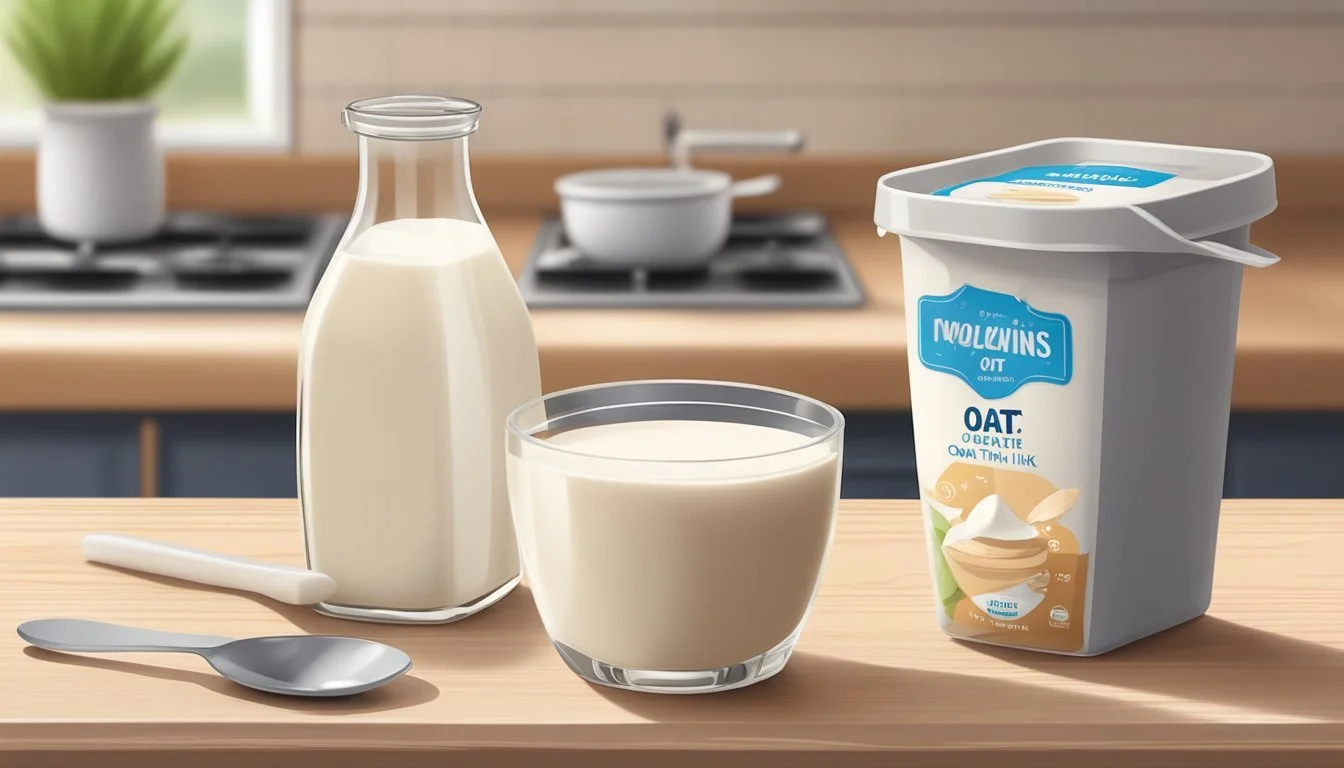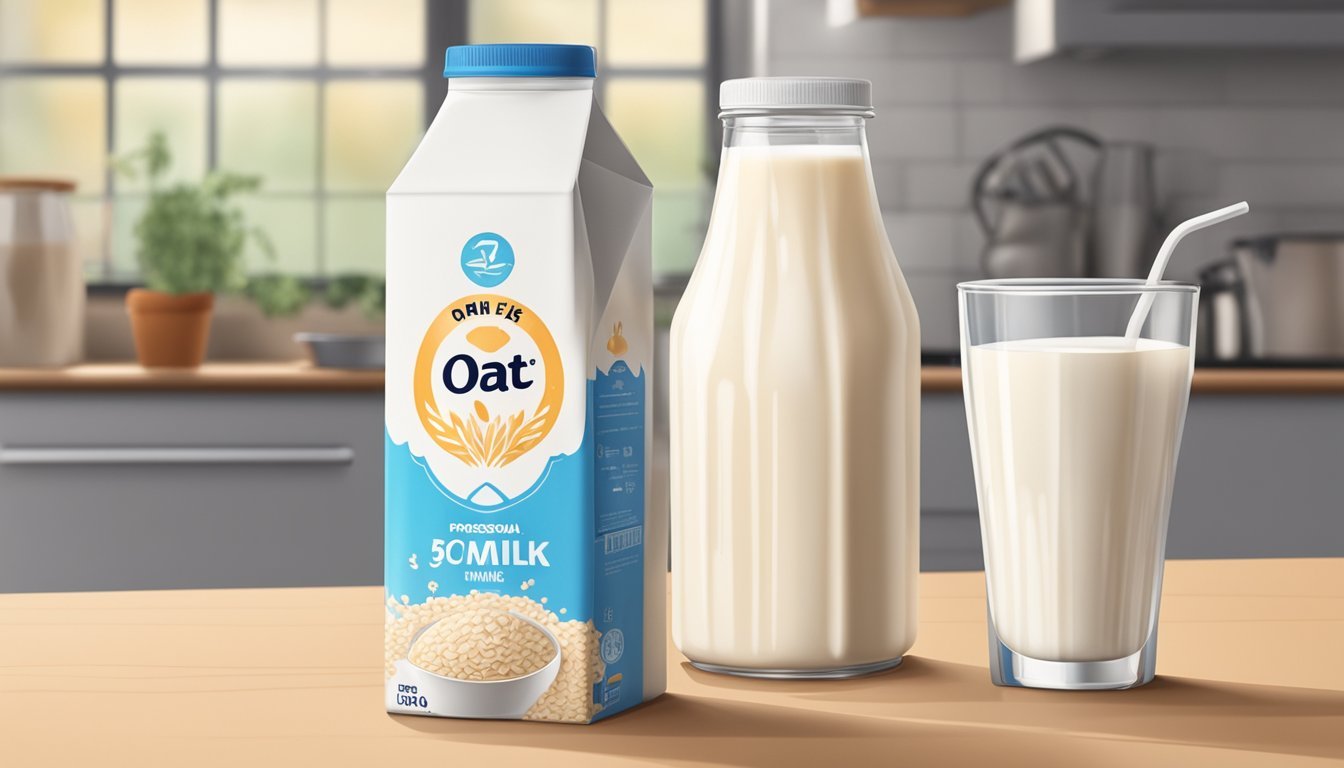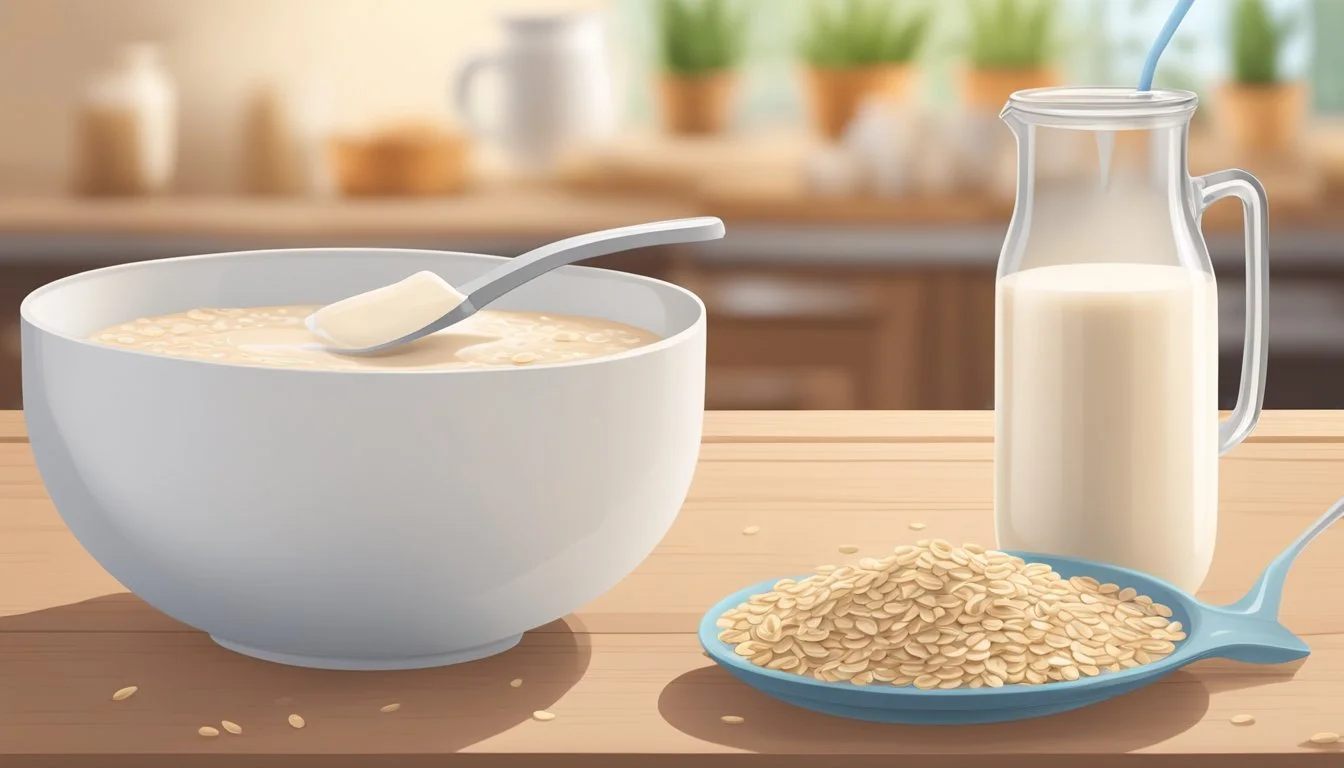How to Substitute Oat Milk for Cow's Milk
A Guide to Dairy-Free Alternatives
Substituting oat milk for cow's milk is an increasingly common practice for those seeking a plant-based milk alternative. Oat milk's rise in popularity stems from its creamy texture and slight sweetness, which makes it a versatile dairy alternative for a variety of recipes. It's particularly appealing for individuals who are lactose intolerant, have a dairy allergy, or follow a vegan diet, but it also resonates with those who are conscious about the environmental impact of dairy farming.
When it comes to cooking and baking, oat milk can typically be used as a one-to-one replacement for dairy milk. Its consistency and flavor profile allow it to seamlessly integrate into dishes ranging from creamy sauces to tender baked goods, without significantly altering the taste or texture. Additionally, oat milk contributes a subtle oat flavor that can complement the overall flavor profile of the recipe.
However, the functionality of oat milk as a substitute may vary depending on the recipe and the type of oat milk used. Full-fat oat milk varieties tend to yield better results in recipes that require a certain fat content for texture and stability. For those considering making the switch, it’s important to be aware of these nuances to ensure successful culinary endeavors while adhering to dietary preferences and restrictions.
Understanding Oat Milk
As oat milk grows in popularity, particularly among those seeking dairy-free and vegan alternatives, understanding its nutritional makeup and comparison to other plant-based milks is essential for informed consumption.
Nutritional Profile and Benefits
Oat milk is a vegan, dairy-free beverage made from blended water and oats. It naturally contains proteins, fibers, and is often fortified with vitamins and minerals such as calcium, vitamin B12, vitamin A, and vitamin D. The table below outlines the notable components of oat milk:
Nutrient Benefit Protein Essential for tissue repair and muscle growth Fiber May contribute to heart health and stable blood sugar levels Healthy Fats Can support cardiovascular health Carbohydrates Provide energy; includes beneficial soluble fiber Vitamins & Minerals Often fortified with essential vitamins and minerals
Certified gluten-free versions are available for individuals with a sensitivity or allergy to gluten, making it a suitable option for those with celiac disease or gluten intolerance.
Comparison with Other Plant-Based Milks
Comparing oat milk to other non-dairy milks such as almond, soy, cashew, coconut, and rice milk illuminates its unique features:
Protein Content: Soy milk often has more protein than oat milk, while almond and rice milk generally have less.
Allergy Considerations: Oat milk is preferable for individuals with nut allergies as it does not contain nuts, unlike almond or cashew milk.
Health Considerations: Coconut milk has higher levels of saturated fats, whereas oat milk usually has a balance of healthier fats.
Fiber Content: Oat milk provides more dietary fiber compared to other plant-based milks, contributing to its health benefits.
It's important to note that plant-based milks' nutritional profiles can vary based on whether they're homemade or commercial, and if they're fortified. Always check the label for a comprehensive understanding of the product.
Preparing for Substitution
When substituting oat milk for cow's milk, it's essential to consider the type of oat milk to use and the correct substitution ratios to maintain the integrity of the recipe.
Choosing the Right Oat Milk
Selecting the appropriate oat milk impacts the overall taste and consistency of the dish. Unsweetened, high-quality oat milk is typically recommended, as it closely mimics the neutral base of cow's milk; however, its inherent sweetness can affect the flavor profile. When texture is crucial, the creamy texture and thickness of oat milk should be factored in. Ingredients lists should be reviewed to avoid unwanted additives, such as added sugars or flavors.
For individuals with dietary constraints, gluten-free oat milk is advisable, ensuring the absence of gluten that could be present in oats due to cross-contamination. Always check the packaging to confirm if the oat milk is gluten-free.
Substitution Ratios
Employing the correct oat milk to cow's milk substitution ratio is pivotal for recipe success. Generally, a 1:1 ratio works well for most baking and cooking applications due to oat milk's similar viscosity and thickness. For baked goods requiring buttermilk, one can mix oat milk with a small amount of white vinegar or lemon juice to replicate the acidity and texture of buttermilk, allowing it to sit and curdle before use.
To summarize the substitution ratios:
Baking & Cooking: Use a 1:1 substitution ratio of oat milk to cow's milk.
Buttermilk Replacement: Add 1 teaspoon of white vinegar to 1 cup of oat milk and let it curdle for a few minutes.
Cooking with Oat Milk
Oat milk serves as a reliable plant-based substitute in both sweet and savory dishes, though one should be mindful of its effects on texture and behavior under heat treatment.
Sweet and Savory Dishes
When incorporating oat milk into sweet recipes such as cakes, cookies, and smoothies, its natural sweetness enhances the flavor profile. For savory dishes, including sauces, soups, and gravies, oat milk imparts a mild, creamy taste without overpowering other ingredients. Chefs often opt for oat milk in recipes, provided the preparation does not require thickening or curdling – properties less pronounced in oat milk than in cow's milk.
Sweet dishes:
Desserts: Puddings, pastries
Beverages: Coffee, tea
Savory dishes:
Soups: Tomato, butternut squash
Sauces and Gravies: Bechamel, mushroom sauce
Heat Treatment and Texture
While oat milk can generally tolerate being heated, caution is advised when exposing it to high heat due to potential separation. The creamy texture of full-fat oat milk offers better viscosity, which is particularly beneficial for recipes that require a creamy consistency. When baking, oat milk can replace cow's milk on a 1:1 basis, but it is essential to note that certain breads may end up with a gummy texture. Therefore, experimentation and slight adjustments to the quantity of oat milk may be necessary to achieve the desired consistency.
Baking with Oat Milk
When substituting oat milk for cow's milk in baking, it's crucial to consider the impact on texture and taste of the baked goods. Oat milk offers a neutral flavor profile and a creamy texture that can enrich cakes and muffins, though attention to moisture and consistency is necessary for optimal results.
Cakes and Muffins
For cakes and muffins, oat milk serves exceptionally well as a one-to-one substitute due to its similar viscosity with dairy milk. It maintains the necessary moisture in these confections without altering the flavor significantly. However, the baker should opt for full-fat oat milk variants to ensure the richness of the baked goods is preserved. It is also important to shake the oat milk container prior to use to evenly distribute any settled contents, providing a uniform blend throughout the batter.
Adjusting Moisture and Consistency
While oat milk can generally be used in a straightforward measure-for-measure exchange, there are instances when adjustments to the baking recipe may be required. Some oat milks contain added stabilizers or gums, which can influence the overall moisture and consistency of the batter. In the event that a recipe turns out too moist, reducing the amount of oat milk slightly or incorporating a thickening agent can rectify the consistency. Conversely, if the batter is too thick, a small increment of water can be added to achieve the desired texture. It is always beneficial to start with the direct substitute and make minor alterations as needed, recording any modifications for future reference.
Oat Milk in Beverages
When substituting oat milk for cow's milk in beverages, it is essential to consider the unique flavor and creaminess that oat milk brings to drinks. There are specific tips for using oat milk in coffee, tea, and other variety of beverages to preserve their delightful texture and taste.
Coffee and Tea
Oat milk has gained popularity for its ability to create a creamy texture similar to that of dairy milk, which works especially well in coffee and tea. For coffee enthusiasts who enjoy a latte or cappuccino, oat milk steamed and frothed can provide an excellent creamy consistency. Since it has a naturally sweet and sometimes earthy flavor, oat milk complements the robust notes of coffee. A 1:1 ratio is typically recommended when substituting oat milk in coffee or tea, but individuals may adjust according to personal taste preferences.
Smoothies and Other Drinks
In smoothies and other drinks, oat milk can serve as a flavorful plant-based alternative to dairy milk. Given its creamy texture, oat milk offers a more substantial body to smoothies, which can enhance the overall drinking experience. For flavored beverages or those requiring some sweetness, unsweetened or flavored varieties of oat milk can be chosen accordingly. While using oat milk in smoothies, maintaining a 1:1 ratio with the amount of dairy milk originally called for in recipes is an effective starting point. Users should always ensure to shake the carton of oat milk before use to avoid inconsistency due to potential separation.
Dealing with Dietary Restrictions
When individuals with dietary restrictions require a non-dairy milk alternative, oat milk is a commendable option. It caters especially to those experiencing lactose intolerance, certain allergies, or adhering to a vegan diet. Unlike dairy milk, oat milk is both lactose-free and dairy-free, making it suitable for individuals who avoid animal products or have lactose-related issues.
For people with gluten sensitivities, caution is advised as oats can sometimes be processed in facilities that also handle wheat. It's important to select oat milk that is explicitly labeled gluten-free to ensure it's safe for a gluten-free diet.
Allergies: Not all non-dairy alternatives are suitable for people with allergies, as some contain nuts or soy. Oat milk, however, is generally free of these allergens—though it's crucial to check the label for certifications and allergen statements.
Intolerance: Oat milk can also be a gentle alternative for those with dairy intolerance, providing a creamy texture that replicates the mouthfeel of cow's milk without triggering common intolerances.
Vegan Diet: For vegans, oat milk offers a plant-based milk option that can seamlessly replace cow's milk in various recipes and uses.
Oat Milk Attributes Relevance for Dietary Restrictions Lactose-Free Safe for lactose intolerance Dairy-Free Suitable for vegans and milk allergies Gluten-Free* Must be verified for gluten intolerance
*Check packaging to confirm
In baking and cooking, those with dietary restrictions can substitute oat milk at a one-to-one ratio for dairy milk, though one should note that the outcome may vary slightly due to difference in fat and protein content. Oat milk imparts a subtle sweetness and smooth consistency that can enhance the flavor profile of many dishes while maintaining dietary compliance.
Storing and Preserving Oat Milk
When incorporating oat milk as a substitute for cow's milk, proper storage is critical to maintain its quality and extend shelf life. Oat milk should be stored in the refrigerator immediately after preparation or opening. It is advisable to keep it in a glass bottle or jar with an airtight lid to retain freshness.
Shelf Life:
Unopened, store-bought oat milk: Refer to the expiration date.
Opened, store-bought oat milk: Typically lasts 7-10 days.
Homemade oat milk: Consume within 3-5 days.
Tips for Preservation:
Temperature: Keep at or below 40°F (4°C).
Container: Use a clean, airtight container.
Storage: Place it away from the refrigerator door to avoid temperature fluctuations.
Handling After Use:
Recap: Ensure the lid is secure after each use.
Clean Utensils: Only use clean utensils to scoop or pour.
Substitution: When used in recipes that call for refrigeration, oat milk follows the same storage guidelines as cow's milk. However, due to its composition, oat milk may separate when thawed if it is frozen, so it's better suited for cooked dishes rather than direct substitution in cold drinks or products.
Caution: Do not consume oat milk that smells sour or has visible mold. Always check for any signs of spoilage before use.
Additional Tips for Using Oat Milk As a Substitute
When using oat milk as a substitute for cow's milk in recipes, it's essential to consider several factors to maintain the desired taste and texture. Here are some tips:
Consistency and Thickness: Oat milk generally matches the viscosity of cow's milk, which helps in maintaining the consistency of the recipe. If the oat milk is too thin, one could reduce the liquid or add a thickening agent like a flour or starch.
Flavor Profile: Unflavored oat milk is suitable for both sweet and savory recipes. Be sure to choose unflavored varieties to avoid unwanted sweetness, especially in savory dishes. Additionally, oat milk lacks the fats that cow's milk has, which could slightly alter the richness of the dish.
Nutritional Considerations: Oat milk contains fiber and may have added sugars or oils, which can affect the nutritional profile of your dish. Check the label for these additions if they are a concern.
Heat Stability: In cooking, oat milk performs well under heat, though it might not foam as dairy milk does for coffees or lattes.
Aspect Consideration When Substituting with Oat Milk Sweet recipes Choose unflavored oat milk to control sweetness. Savory recipes Unflavored variants will not alter the taste. Consistency Adjust with thickeners if necessary. Richness Lack of fat may reduce creaminess. Nutritional value Be aware of fiber, added sugars, and oils.
Readers seeking a plant-based alternative will find oat milk to be a versatile milk substitute. While substitutions can be made one-for-one with cow's milk in most cases, one should keep these considerations in mind for optimal results.
Conclusion
Substituting oat milk for cow's milk in recipes is a viable option for those looking for a plant-based alternative. Oat milk is appreciated for its creamy texture and mild flavor, making it suitable for a variety of dishes. Chefs and home cooks alike can use oat milk in baking, beverages, and savory recipes, often without any significant changes in taste or texture.
However, individuals considering oat milk as a substitute should be aware that it has a distinct flavor which may be noticeable in some recipes. The properties of oat milk can differ from cow's milk; for example, it may not curdle or thicken in the same way. Adjustments in recipes might be necessary to achieve the desired consistency.
For those concerned with nutrition, it’s crucial to note that oat milk is not inherently healthier than cow’s milk; each has its own set of nutrients. Oat milk typically offers fiber and is often enriched with vitamins and minerals. On the other hand, cow's milk naturally contains protein and calcium.
In summary, while oat milk offers a nutritious and environmentally friendly alternative, it's essential to consider the specific requirements of a recipe when making substitutions. Those with allergies or dietary preferences can successfully incorporate oat milk into their cooking, enjoying a wide range of culinary creations.







